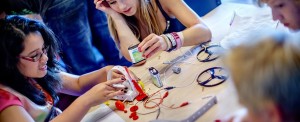Within the Hypatia Project (http://www.expecteverything.eu/hypatia/facts-figures/), the university of Copenhagen have made a framework for gender inclusion. This framework we use in this project to develop new activities for teenagers 13-16 years old.
What is the problem?
 Research shows that the way sciences are communicated to youth, in and out of school, is not yet gender inclusive. What is more, young Europeans, both girls and boys, still have very little idea of the variety of careers that are possible in science, technology, engineering, and mathematics (STEM), and the skills that are relevant for those career pathways. In the coming years, with Europe’s knowledge economy developing and new technologies on the rise, skills in STEM will be needed for a broader range of careers than ever before.
Research shows that the way sciences are communicated to youth, in and out of school, is not yet gender inclusive. What is more, young Europeans, both girls and boys, still have very little idea of the variety of careers that are possible in science, technology, engineering, and mathematics (STEM), and the skills that are relevant for those career pathways. In the coming years, with Europe’s knowledge economy developing and new technologies on the rise, skills in STEM will be needed for a broader range of careers than ever before.
In most of Europe, female students are no longer characterised as non-traditional students, as an increasing proportion of girls attend higher education in general. However, although in Europe slightly more female than male youth attend higher education, many science and engineering study programmes still struggle to attract female students (OECD, 2015). Only one of three STEM graduates is female; a proportion which has changed very little the past 15 years (EUROSTAT, 2011). Furthermore, within STEM there are large variations in the gender distribution of students across study programmes, and within some sciences female students are still the minority. In particular, the biological and medical sciences have more than 50% female students, whereas women are minorities in physics, computer science, and engineering (European Commission, 2009). It is clear that if more female students pursued a STEM-career, the concerns about how Europe will compete in the global STEM knowledge-economy in the future would be alleviated.
Why care about the gender balance in science?
There are a number of rationales for striving towards a wider and more diverse recruitment of students in general and female students in particular to attend higher education STEM. Three important reasons to care about gender balance in science are:
- An economic rationale: If larger proportions of a student population achieve a higher degree of education, Europe will be better prepared to compete in the global knowledge economy.
- A diversity rationale: a diverse student population is a platform for developing innovative ideas and being capable of adapting to the rapidly changing society and to diverse purposes and applications (Bøe, 2013).
- An equity rationale: Higher education is perceived as a result of a democratic process where everyone has equal possibilities for achieving the benefits they produce (Thomsen, 2008).
How to address gender in this project
In this project we develop gender inclusive activities for teenagers 13-16 years old. We try to address the gender issue on two levels.
Higher education is perceived as a result of a democratic process where everyone has equal possibilities for achieving the benefits they produce.
Individual level
In the activities we develop, we pay special attention to the different learners who will be the target group of these activities. We will do this by acknowledging the different starting points of the learners, implementing different trajectories of inquiry, challenging learners to depart from their preferred interests and widen their engagement in science. We ensure that the diversity of science is represented to the largest extent possible in the activity.
Interactional Level
The interactional level is the level where the participants interact with each other. At this level, among other things in the development of the activities we ensure that the activity has a balanced approach to the participants’ learning preferences, i.e. includes thinking tasks, motor skill tasks, and value-related tasks together with a variation of different interaction forms.
